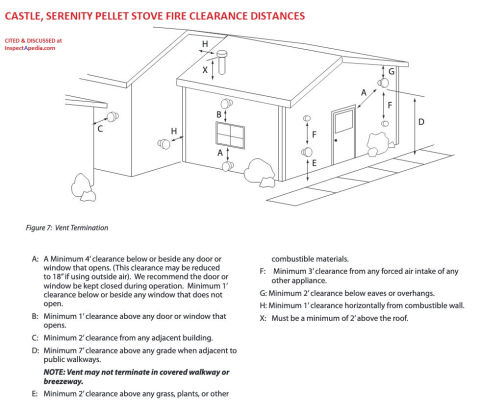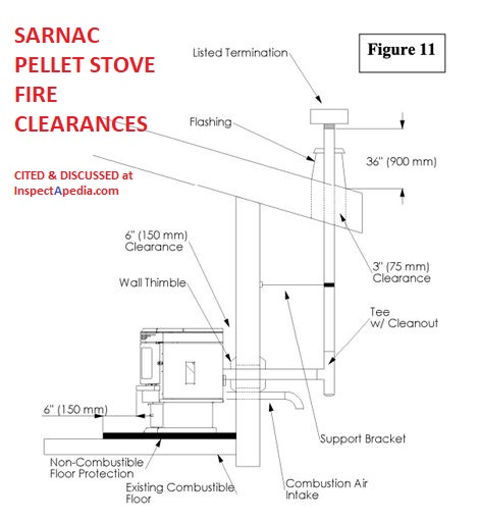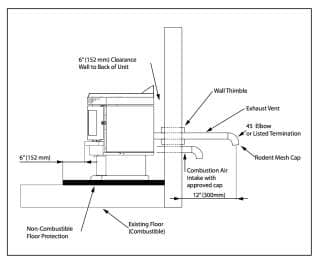 Pellet Stove Fire Clearances
Pellet Stove Fire Clearances
Fire clearance distances & Pellet Stove Manuals
- POST a QUESTION or COMMENT about fire safety clearances for woodstoves and coal stoves
Pellet stove fire clearance distance specifications & manuals:
This article describes fire safety distances required between pellet stoves and the nearest combustible surface and the clearance distances between a pellet stove chimney or vent and other building features.
We include free downloads of PDF copies of a range of pellet stove installation and maintenance manuals that add detail about pellet stove installation and clearances for various models.
InspectAPedia tolerates no conflicts of interest. We have no relationship with advertisers, products, or services discussed at this website.
- Daniel Friedman, Publisher/Editor/Author - See WHO ARE WE?
Pellet Stove Fire Clearance Distances
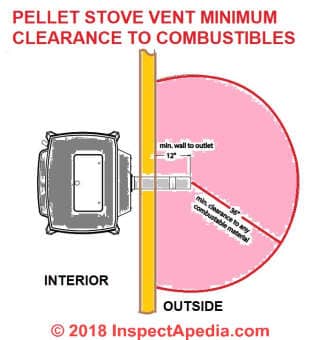 Question: pellet stove exhaust vent clearances
Question: pellet stove exhaust vent clearances
Illustration: an example exterior wall and roof eaves clearances for a pellet stove, adapted from the Harman pellet stove instructions. Harmon is cited in detail below.
[Click to enlarge any image]
Watch out: the fire clearances and exhaust vent clearances for your specific pellet stove are likely to vary from these examples.
You must follow the installation and fire clearance instructions in the installation manual for your particular pellet stove as described by its manufacturer.
Failure to follow those instructions risks a fire, injury or worse, death.
2018/10/13 Rick said:
Pellet stove instillation, how close can vent exhaust pipe be to outside pressure treated stairs running along my foundation?
Reply: example pellet stove fire and exhaust vent clearances
Rick
Using this example from Afton Bay pellet stove installation instructions, I'd guess that you need to be 12" from combustibles - that would include pressure treated stairs.
Watch out: in fact you need to see the specific vent clearances and other fire clearances given in the installation manual for your specific pellet stove brand and model and for the brand and model of its exhaust vent components if those are produced separately.
Below are more Pellet Stove exhaust vent clearance details compiled from several installation manuals.
- The exhaust vent pipe must extend at least 12” (300 mm) out past the exterior wall.
- Install a listed horizontal termination cap or if necessary install a 90° elbow and appropriate length of vertical venting.
A listed vertical vent cap is recommended however (if local codes allow) when the vent terminates several feet above ground level and there are no trees, plants, etc. within several feet a 45° elbow can be used as a termination. - The elbow must be turned down to prevent rain from entering
- The outside air pipe must terminate above the maximum snow line and below the exhaust vent outlet.
Shown above: Intertek Pellet Stove clearances for the Intertek Sarnac model.
Pellet Stove Chimney & Vent Clearance Distances, Installation & Operation Manuals
Above: Pellet stove sidewall vent terminal locations and clearance distances including from windows, doors, gas meter, roof eaves and ground surface, adapted from Harman, cited in detail below.
. [Click to enlarge any image]
These manuals give examples of pellet stove installation requirements including fire clearances and venting.
Wood stove manuals are given separately
- CASTLE SERENITY PELLET STOVE INSTALLATION INSTRUCTIONS [PDF] (2014) Ardisam, Inc., Castle Stoves™, Division d’Ardisam, Inc.1160 8th Avenue, PO Box 666Cumberland, WI 54829 USA Tel: 800-345-6007 | Télécopie 715-822-2223Courriel : info@castlestoves.comwebsite: www.castlestoves.com
- DuraVent CVS CONCENTRIC STAINLESS VENT SYSTEM for PELLET STOVES [PDF] retrieved 2021/05/19 original source: https://duravent.com/wp-content/uploads/2019/12/L916.pdf
Dura-Vent Chimney Installation Instructions for the company's various models can be found at https://duravent.com/installation-instructions/ - DuraVent, DURACHIMNEY® INSTALLATION INSTRUCTIONS [PDF] Air-Cooled, All-Fuel Chimney for Fireplaces, DuraVent Co., Tel: : 800-835-4429 Website: www.duravent.com
Excerpt: DuraChimney is designed to stay cool on the outside, to provide a hot draft on the inside, and to provide for a fire-safe design that protects both the chimney and the building. The double-wall air-cooled design allows the chimney to expand under high temperatures.
...|
Warranty excerpt: Ventinox liner and components in wood, oil, wood pellet, and gas installations are warranted at One Hundred Percent (100%) for the lifetime of the original homeowner; - Harman PELLET STOVE MANUAL [PDF] (2017) Harman, 352 Mountain House Road, Halifax, PA 17032 USA Website: www.harmanstoves.com retrieved 2018/10/13, original source: https://downloads.hearthnhome.com/installManuals/XXV_I.pdf
Excerpts on fire clearances:
In addition, the following must be observed:
A. The clearance above grade must be a minimum of 12".
B. The clearance to a window or door that may be opened must be a minimum of 48" to the side, 48" below the window/door, 12" above the window/door. (with outside air installed, 9” to side and below)
C. A 12" clearance to a permanently closed window is recommended to prevent condensation on the window.
D. The vertical clearance to a ventilated soffit located above the terminal within a horizontal distance of 2 feet (60 cm) from the center-line of the terminal must be a minimum of 18".
E. The clearance to an unventilated soffit must be a minimum of 12".
F. The clearance to an outside corner is 11" from center of pipe.
G. The clearance to an inside corner is 12".
H. A vent must not be installed within 3 feet (90 cm) above a gas meter/regulator assembly when measured from the horizontal center-line of the regulator.
I. The clearance to service regulator vent outlet must be a minimum of 6 feet.
J. The clearance to a non-mechanical air supply inlet to the building or the combustion air inlet to any other appliance must be a minimum of 48”.
K. The clearance to a mechanical air supply inlet must be a minimum of 10 feet. (with outside air installed, 6 feet)
L. The clearance above a paved sidewalk or a paved driveway located on public property must be a minimum of 7 feet.
M. The clearance under a veranda, porch, deck or balcony must be a minimum of 12 inches. (B. also)
NOTE: The clearance to vegetation and other exterior combustibles such as mulch is 36” as measured from the center of the outlet or cap. This 36” radius continues to grade.
Certain Canadian and or Local codes or regulations may require different clearances.
A vent shall not terminate directly above a side-walk or paved driveway which is located between two single family dwellings and serves both dwellings. Only permitted if veranda, porch, deck, or balcony is fully open on a minimum of 2 sides beneath the floor.
See NFPA 211 for more installation clearance reductions when using outside air. NOTE: Where passage through a wall, or partition of combustible construction is desired, the installation shall conform to CAN/CSA-B365. (if in Canada) - Intertek Sarnac PELLET STOVE MANUAL [PDF] Intertek Warnock Hersey, Hudson Stove Works, 1871 Route 9H Hudson, NY 12534 U.S.A. Tel: 518-828-6363 , retrieved 2018/10/13, original source: http://www.hudsonriverstoves.com/pdf/saranac.pdf
- Intertek 5660-PELLET STOVE MANUAL [PDF] United States Stove Company, 227 Industrial Park Road, South Pittsburg, TN 37380 USA, Website:
www.usstove.com
Tel: 1-800-750-2723, retrieved 2018/10/13, original source: https://www.usstove.com/Manuals/USSC/5660.pdf
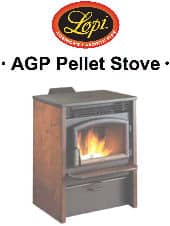 Illustration: the Lopi AGP Pellet Stove from Travis Industries, cited in detail below
Illustration: the Lopi AGP Pellet Stove from Travis Industries, cited in detail below
- Lopi AGP PELLET STOVE IO MANUAL [PDF] (2013) Travis Industries, Inc. 4800 Harbour Pointe Blvd. SW Mukilteo, WA 98275 USA , Website: www.travisproducts.com, retrieved 2018/10/13, original source: https://www.lopistoves.com/TravisDocs/100-01330.pdf
- Piazzetta P963-PELLET STOVE MANUAL [PDF] Groupo Pizzaetta, Via Montello 22, 31011 Casella D'Asolo (TV) Italy Tel. +39.04235271
Website: www.piazzetta.it E-mail:infopiazzetta@piazzetta.it
Distribuite by: Pacific Energy Fireplace Products Ltd. 2975 Allenby Rd. Duncan, BC, Canada V9L 6V8 Tel: 1-250-748-1184 email: support@pacificenergy.net - retrieved 2018/10/13, original source: https://www.piazzetta.com/files/3514/0865/9916/p963.pdf - SELKIRK DIRECT-TEMP VENT SYSTEM FOR PELLET STOVE HEATERS [PDF] retrieved 2018/10/13, Selkirk Source: http://www.selkirkcorp.com/sitecore/content/global-configuration/selkirk/products/direct-vent/direct-temp--pellet
This venting system for pellet stoves permits as little as 1" clearance from the vent sides to combustibles. Cited in the Intertek 5660 manual PDF given above. - Selkirk, DT Conversion Kit INSTRUCTIONS [PDF] Selkirk Corporation, US & UK offices, US Customer Service
United States
Toll Free: 800.992.8368
Email: info@selkirkcorp.com
For Technical Service - 1.800.748.0392 (press option 5), retrieved 2018/10/13, original source: http://www.selkirkcorp.com/sitecore/content/global-configuration/selkirk/products/direct-vent/direct-temp--pellet used for adapting model DT to factory built and masonry chimneys - Selkirk DT to PL Conversion Kit INSTRUCTIONS [PDF] op. cit.
- St Croix Afton Bay-PELLET STOVE IO MANUAL [PDF] ..., retrieved 2018/10/13, original source: stcroixstoves.com/pdf/installation/Afton-Bay.pdf
- Whitfield Cascade PELLET STOVE MANUAL [PDF] (2003) Whitfield, Lennox Hearth Products, 110 West Taft Ave., Orange CA 92865 USA, retrieved 2018/10/13, original source: http://woodpelletheat.com/CascadeStoveManual.pdf
...
Reader Comments, Questions & Answers About The Article Above
Below you will find questions and answers previously posted on this page at its page bottom reader comment box.
Reader Q&A - also see RECOMMENDED ARTICLES & FAQs
On 2022-04-30 by Inspectapedia Com Moderator - does a pellet stove require a heat shield between it and the outside wall?
@John,
Thanks that's a helpful question.
It's important to follow the manufacturer's instructions from the pellet stove installation manual. This 'may' differ from what the professional installer thinks is sufficient if that installer is not employed by the manufacturer.
The requirement for a heat shield may be dependent on the type of wall construction and exterior cladding. But most direct-vent systems are designed to use a thimble and to extend far enough through the wall that combustion products don't harm the wall nor create a fire risk.
Identify the brand and model of your pellet stove so that we can both look at its installation instructions.
In general, if you followed the venting instructions specified by the manufacturer that ought to be both safe and code compliant.
So you can try showing that to your insurance company.
Watch out: be sure we're all on the same page here. Could there be confusion between the exterior surface of the exterior wall (that's what I discussed above)
and
the interior surface of the wall?
Indeed depending on its distance from an interior wall (or other combustibles) a heat shield may be absolutely necessary to avoid a fire.
(At least some pellet stoves are sold with an integral heat shield that attaches to the stove.)
So just as in my notes above about the outside surface of your exterior wall, you want to read the pellet stove installation manual for its required clearance-distances to combustibles (including a wood-framed wall), and for the requirements for a heat shield.
Below I excerpt as an EXAMPLE - THIS IS NOT FOR YOUR PELLET STOVE - as you haven't identified its brand and model:
CLEARANCES TO COMBUSTIBLES
INSTALL VENT AT CLEARANCES SPECIFIED BY THE VENT MANUFACTURER.
When the unit is being installed on a combustible floor a 1/2" thick non-combustible
hearth pad must be installed under the unit. The pad must extend at least the width of the
appliance and at least the depth of the appliance plus 6" (152 mm) in front of the
appliance. This applies for both the freestanding unit and the insert.
INSTALLING YOUR ROOM HEATER
Your first step is to decide where to install your pellet stove. In order to get the best use
of circulated heat we recommend too install it in a large open room centrally located in
the house.
Next it is very important to check that clearances to combustibles are maintained, these
can be found on page 14 of this manual and on the rating label of the pellet stove.
The pellet stove can be vented through an exterior wall or into an existing masonry or
metal chimney. The chimney must be lined if over 6” (150 mm) in diameter or if it has a
cross sectional area of over 28 square inches. Venting can pass through the ceiling and
roof if listed pipe is used.
Do not obtain combustion air from the attic, garage or any other unventilated area. You
may obtain combustion air from a ventilated crawlspace.
DO NOT INSTALL A FLUE DAMPER IN THE EXHAUST VENTING SYSTEM OF THIS UNIT.
DO NOT CONNECT THIS UNIT TO A CHIMNEY FLUE SERVING ANOTHERAPPLIANCE.
INSTALL VENT AT CLEARANCES SPECIFIED BY THE VENT MANUFACTURER.
This appliance is certified for use with listed “PL” or “L” pellet venting products as well
as Selkirk’s Direct-Temp Vent system for pellet burning appliances
Excerpted from:
- Intertek Saranac PELLET STOVE INSTALLATION INSTRUCTIONS [PDF] Hudson River Stove Works, 1871 Route 9H, Hudson, NY 12534
U.S.A. Phone: 518-828-6363 - retrieved 2022/0430, original source: http://www.hudsonriverstoves.com/pdf/saranac.pdf
Stove Manufactured by Inca Metal Cutting Ltd., 2771 Viscount Way, Richmond, BC V6V 2X4 Canada
On 2022-04-30 by John
Does a professionally installed corner unit pellet stove require a heat shield between it and the outside wall? My insurance company says it does and I think it does not according to the company that installed it.
On 2022-01-01 by Inspectapedia Com Moderator - codes and standards for pellet stove chimney piping
@Mike, NJ USA,
First about the permit: I think you may be fine but it's definitely worth a call to your local building department to confirm that you didn't need a new permit to change heating appliances.
In fact, independent of the permit question, it's possible that some additional work was needed or at least would have been "recommended" including a chimney inspection and cleaning and in some cases, a lining required.
A wood burning stove can leave creosote deposits that, if later ignited, can cause a catastrophic chimney fire. The fact that you've run your pellet stove for nearly two decades without such a terrible event is of course encouraging and good news. But if you want to be safe, have the chimney inspected for safety, including creosote deposits AND for damage such as broken flue liners, cracks, gaps. If the chimney is clean and un-damaged that closes those questions.
Next: you can vent a pellet stove into an existing chimney, including a masonry one, provided the chimney provides adequate draft. For example, venting a small appliance with low BTU output into a very large flue may run into a problem of inadequate draft. [When the manufacturer says a "Class A" chimney is not required and that a Type -L vent is permitted, that does not mean (in my OPINION - check with the manufacturer) that you can not use a Class A chimney if you already have one.]
For a pellet stove, though less common than with a catalytic firewood-burning woodstove, if you had insufficient draft you might have noticed that as improper stove operation or, as you can see at WOOD STOVE, CATALYTIC PUFF-BACKS inspectapedia.com/heat/Catalytic-Wood-Stoves.php you might have had a problem with smoking or puffing.
In sum, if there are no draft problems and your stove works properly, what remains as good practice would be a chimney flue inspection for safety.
Do let me know what happens: what you report will help other readers.
Thank you for the helpful questions and also for your nice comments about our work. We worked hard on this material for decades and so we were especially grateful when readers find it useful and trusted.
For other readers: here is a copy of the
BRECKWELL LP2700 PELLET STOVE IO MANUAL [PDF]
Excerpt: [Note the comments about chimney type and material]
VENTING
The Breckwell P2700 is certified for use with listed TYPE L-Vent, 3” or 4” diameter in size. The stove was tested with Simpson Duravent brand. Class “A” chimney is not required. Refer to the instructions provided by the vent manufacturer, especially when passing through a wall, ceiling or roof.
This is a pressurized exhaust system. All vent connector joints must be sealed with 500F (260C) RTV silicone sealant to ensure consistent performance and avoid smoke spillage. All horizontal connector joints must be sealed with UL-181-AP foil tape. We recommend that all vertical vent connector joints be secured with a minimum of 3 screws.
It is strongly recommended that you have a minimum of 6’ of vertical pipe in your exhaust system. For best performance of the stove limit the number of elbows and horizontal pipe as much as possible
DO NOT CONNECT THIS UNIT TO A CHIMNEY FLUE SERVING ANOTHER APPLIANCE.
DO NOT INSTALL A FLUE DAMPER IN THE EXHAUST VENTING SYSTEM OF THIS UNIT.
INSTALL VENT AT CLEARANCES SPECIFIED BY THE VENT MANUFACTURER.
here is the actual text from the Breckwell P2700 instructions and the illustration we excerpted
D. VERTICALLY INTO EXISTING MASONRY FIREPLACE
NOTE: Follow L-Vent chimney manufacturer’s instructions.
1. Have the masonry chimney inspected by a qualified chimney sweep or installer to determine its structural condition.
2. You will need a pipe length equal to the chimney height from the hearth. If outside combustion air is to be used, you will need a pipe length equal to the chimney height plus 18 inches.
3. Install a blanking plate and the chimney pipe, and if used the outside air pipe, as shown in Figure 9.
4. Attach the L-vent adapter, a section of pipe and clean out tee, making sure the clean out tee is centered in the chimney flue area. Use RTV, metallic tape, and a minimum of three self-tapping screws at all joint connections to ensure a tight seal.
5. Position the stove, adhering to the clearances in Figures 1 & 2.
6. Measure and build chimney top plate. Cut out holes for chimney pipe, and if used the outside air pipe. Install and seal with non-hardening mastic to prevent water leakage. Install vent cap.
On 2022-01-01 by Mike, NJ USA
Hi, love this information you provide. I have a Breckwell P2700 Pellet Stove in my basement. Previously it had a wood burning stove which vented into an exterior chimney.. Because the wood stovev was not safe when I bought the house 19 years ago. I replaced it with a pellet stove. Back then, Pellets were unheard of in the area so it was new territory for anyone I spoke to.
I installed it paying attention to clearance minimums in the manual.. I also put the 4" pipe through a thimble on its way through fake brick wall and into the chimney. It goes straight into the chimney. I do NOT have any pipe/flex pipe connected after that point once it arrives into the chimney as back then I was told the added chimney piping was not mandatory in the existing chimney. I think it has a clay liner in the chimney.
Question #1 - Given code changes over decades, can you advise me if I need to have some sort of vertical pipe going through the chimney to the top ?
Question #2 - Just to reconfirm, is it still the case that the standard 36" clearance for a wood stove does NOT apply to pellet stove which manufacturers advise of only like a 3" minimum clearance on the pellet stove ?
Also permit question - back 19 years ago I began the permit process for the pellet stove but did not move forward with that process.
I would have to look at my records but I think I filled out the forms but never completed process/called for inspection because I also learned a permit was not necessary as this was not New construction, merely a replacement of an appliance of similar like in the same exact hole/chimney (Wood burning to wood pellet burning) .
Your thoughts ?
Thank you and Happy new year.
On 2021-11-02 by inspectapedia.com.moderator
@David Langille,
Yes, given in the installation instructions for your specific stove brand and model, fuel, etc.
On 2021-11-02 by David Langille
Is there a minimum stove pipe height? I have installed in the basement with a five foot rise indoors to an elbow, 2 foot horizontal to the outside cleanout which sits four feet about grade. No windows or other vents on the wall.
On 2020-11-09 by danjoefriedman (mod) - is it ok to vent a pellet stove sidewall exhaust downwards then out through the wall?
Jason:
Thanks for the question: is it ok to vent a pellet stove sidewall exhaust downwards then out through the wall?
Sorry but I'm doubtful that there could be one generic yes or no answer that would be right for all cases.
In general we never vent a stove downwards as we want it to draft properly, but I know that many pellet stoves use a power vent, so what you want to do might be permitted.
You should identify your stove's brand and model, then check the installation/operation manual for it to see what the manufacturer says is permitted; if that's not clear then you'd call the company's customer support to ask.
Do NOT change your stove venting before confirming with the manufacturer that it's ok since otherwise your stove may not work properly and it could be unsafe, risking fire or CO hazards.
On 2020-11-08 by Jason
Hello, I have an existing pellet stove that is vented horizontally straight out the wall. The stove currently sits on a tile floor, and I would like to add a 9" riser underneath the stove without having to add another hole in the exterior wall. Is it ok to raise the stove and use 2, 90° fittings in an "S" shape to connect to the existing vent?
There would be a 1 foot pipe coming horizontally out the back of the stove into a 90° downward fitting, into another 90° fitting connecting to the existing horizontal vent pipe. I'm not sure if the the 9" of downward section would cause venting issues.
On 2020-10-26 by danjoefriedman (mod)
Yes, Don, in some form, as the block itself is hollow.
On 2020-10-26 by Don East
Do I need a thimble to vent a pellet stove thru a concrete block wall?
On 2020-10-19 - by (mod) -
Jody:
See the CASTLE SERENITY PELLET STOVE INSTALLATION INSTRUCTIONS [PDF]
where you'll find contact information for the manufacturer.
Don't vary from their minimum clearance distances without an OK from the manufacturer's technical support rep as you could face a fire or CO hazard.
The illustration below is excerpted from their instructions. - [Click to enlarge any image]
On 2020-10-19 by jody
with an oak installed on my castle serenity how far away from the side of a window can my vent being I can't go 1 foot above the window
On 2020-07-24 by Priscilla
I Live in Albany , Wisconsin( Green County) I have Windows & doors galore. Want to install a pellet stove just not sure if measurements. Have several Windows we don't open but not sure of ordinances. Can't understand some things I've read. Please help!!!
On 2020-04-14 - by (mod) -
Katelin,
in the article above we have as venting limitations
H. A vent must not be installed within 3 feet (90 cm) above a gas meter/regulator assembly when measured from the horizontal center-line of the regulator.
On 2020-04-13 by Katelyn
How far away from propane does this need to be vented? We have 2 100 gal tanks.
On 2020-02-29 - by (mod) -
Wendy if it's a solid masonry non-combustible wall then the fire clearances to the wall would not apply. I'd be concerned if the non-combustible material is just a veneer. In that case the clearances apply.
On 2020-02-28 by wendy
are there specific clearances for a wood stove on a Non Combustible floor and walls?
If it sits on a noncombustible floor and the walls are rock- noncombustible and the rock walls extend out 4 feet on each side of the stove and the noncombustible stone floor under the stove extends out 3 feet on all sides does the back of the stove still have to be more than 5" from that back stone wall, Intertek stove model 2000
On 2020-02-10 - by (mod) -
Amber
Pellet stove fire clearances and venting requirements vary by model. Let's start with the brand and model of your specific pellet stove; then we can look at the manufacturer's specific venting installation requirements. That's safer than a mere guess.
On 2020-02-10 by Amber
Installing a pellet stove in an uninsulated garage. I meed to vent out a window replaced with crment board, 1 ft to the side of where the vent originates on the stove. The pipe immediately runs straight up and then 90 out. The rise would be about 63 inches. Can I do that?
On 2019-11-15 - by (mod) -
David
Probably yes but the final, exactly correct pellet stove exhaust pipe routing including maximum lengths, fire clearances etc will be in the specific Installation & Operation manual for your specific pellet stove brand and model.
We give pellet stove manuals as PDF downloads at inspectapedia.com/chimneys/Pellett-Stove-Fire-Clearances.php#PelletStoveManuals
Or tell me your brand and model and we'll dig that out if you don't have the manual.
Here's an example from the Intertek Sarnac model manual - [ Click to enlarge any image]
On 2019-11-15 by david
4" pellet stove pipe, can you run the pipe 5 feet upright and 4 feet straight out? thanks
...
Continue reading at LABELS & CERTIFICATIONS for WOOD STOVES & PELLET STOVES, or select a topic from the closely-related articles below, or see the complete ARTICLE INDEX.
Or see these
Recommended Articles
- FIRE CLEARANCES INDOORS
- WOOD STOVE OPERATION & SAFETY - home
- COMBUSTION AIR for WOODSTOVES
- DEFECTS LIST - HEAT, WOOD APPLIANCE
- FIRE CLEARANCES, WOOD COAL & PELLET STOVES
- FIREPLACE INSERTS INSTALL, INSPECT, REPAIR
- HEAT SHIELD SPECIFICATIONS for WOOD STOVES & PELLET STOVES
- PELLET STOVE CLEARANCE DISTANCES
- PELLET STOVE DRAFT CONTROL
- PELLET STOVE MANUALS
- WOOD FURNACE FAN LIMIT CONTROL
- WOODSTOVE DRAFT CONTROL
- WOOD STOVE DRAFT TEST
- WOOD STOVE, CATALYTIC PUFF-BACKS
- WOOD STOVE INSTALL CONVERT
- WOOD STOVE INSPECTION CHECKLIST [PDF]
Suggested citation for this web page
PELLET STOVE CLEARANCE DISTANCES at InspectApedia.com - online encyclopedia of building & environmental inspection, testing, diagnosis, repair, & problem prevention advice.
Or see this
INDEX to RELATED ARTICLES: ARTICLE INDEX to CHIMNEYS & FLUES
Or use the SEARCH BOX found below to Ask a Question or Search InspectApedia
Ask a Question or Search InspectApedia
Try the search box just below, or if you prefer, post a question or comment in the Comments box below and we will respond promptly.
Search the InspectApedia website
Note: appearance of your Comment below may be delayed: if your comment contains an image, photograph, web link, or text that looks to the software as if it might be a web link, your posting will appear after it has been approved by a moderator. Apologies for the delay.
Only one image can be added per comment but you can post as many comments, and therefore images, as you like.
You will not receive a notification when a response to your question has been posted.
Please bookmark this page to make it easy for you to check back for our response.
IF above you see "Comment Form is loading comments..." then COMMENT BOX - countable.ca / bawkbox.com IS NOT WORKING.
In any case you are welcome to send an email directly to us at InspectApedia.com at editor@inspectApedia.com
We'll reply to you directly. Please help us help you by noting, in your email, the URL of the InspectApedia page where you wanted to comment.
Citations & References
In addition to any citations in the article above, a full list is available on request.
- Mark Cramer Inspection Services Mark Cramer, Tampa Florida, Mr. Cramer is a past president of ASHI, the American Society of Home Inspectors and is a Florida home inspector and home inspection educator. Mr. Cramer serves on the ASHI Home Inspection Standards. Contact Mark Cramer at: 727-595-4211 mark@BestTampaInspector.com
- Roger Hankeyis principal of Hankey and Brown home inspectors, Eden Prairie, MN, technical review by Roger Hankey, prior chairman, Standards Committee, American Society of Home Inspectors - ASHI. 952 829-0044 - hankeyandbrown.com
- Fire Inspector Guidebook, A Correlation of Fire Safety Requirements Contained in the 1987 BOCA National Codes, (newer edition available), Building Officials and Code Administrators International, Inc. (BOCA), Country Club HIlls, IL 60478 312-799-2300 4th ed. Note: this document is reissued every four years. Be sure to obtain the latest edition.
- Our recommended books about building & mechanical systems design, inspection, problem diagnosis, and repair, and about indoor environment and IAQ testing, diagnosis, and cleanup are at the InspectAPedia Bookstore. Also see our Book Reviews - InspectAPedia.
- In addition to citations & references found in this article, see the research citations given at the end of the related articles found at our suggested
CONTINUE READING or RECOMMENDED ARTICLES.
- Carson, Dunlop & Associates Ltd., 120 Carlton Street Suite 407, Toronto ON M5A 4K2. Tel: (416) 964-9415 1-800-268-7070 Email: info@carsondunlop.com. Alan Carson is a past president of ASHI, the American Society of Home Inspectors.
Thanks to Alan Carson and Bob Dunlop, for permission for InspectAPedia to use text excerpts from The HOME REFERENCE BOOK - the Encyclopedia of Homes and to use illustrations from The ILLUSTRATED HOME .
Carson Dunlop Associates provides extensive home inspection education and report writing material. In gratitude we provide links to tsome Carson Dunlop Associates products and services.




